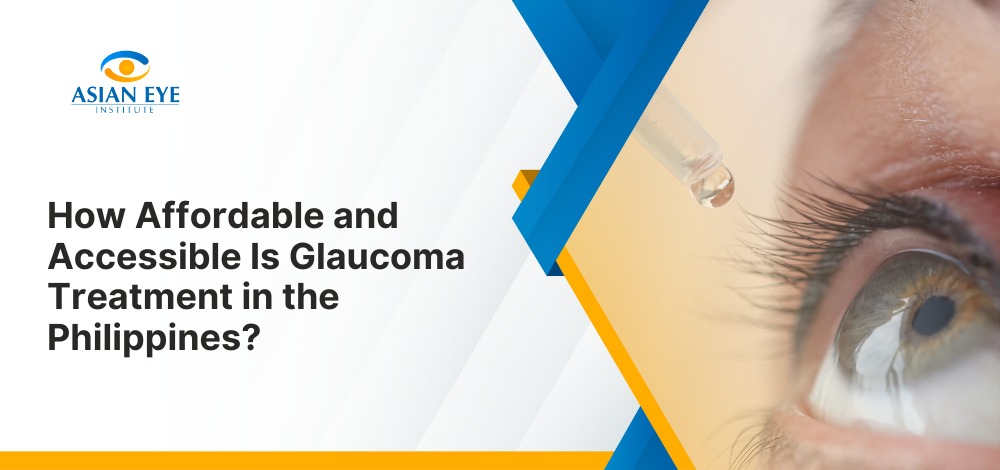
Introduction
Glaucoma is one of the most common eye conditions among Filipinos. It usually develops when excess fluid builds up in the eye, increasing pressure and damaging the optic nerve. Around 300,000 individuals in the country are reported to have the disease, according to a 2021 joint study published by the Philippine Academy of Ophthalmology, Philippine Glaucoma Society, and Novartis Healthcare Philippines, Inc.
Dubbed the “silent thief of sight,” glaucoma barely shows any symptoms until it is in its advanced stages. It is necessary for individuals to have comprehensive eye checkups regularly to detect the disease in its early stages, preserve vision, and prevent complete blindness.
There is currently no known cure for glaucoma, but medications and other treatment options are readily available in the Philippines. This article explores how financially accessible these treatments are to average Filipino patients. Read through the rest of this article to find out.
The Costs of Glaucoma Treatment in the Philippines
Treatment for glaucoma can be expensive. Several factors drive up the cost, such as the following:
Diagnostic Exams
Detecting glaucoma as early as possible is crucial for retaining your eyesight and avoiding irreversible blindness. Your doctor might recommend undergoing tests to diagnose your condition accurately. Some of the exams are:
- Pachymetry – This is done to measure the thickness of your cornea. It is a painless procedure that involves gently placing a pachymeter onto the front part of the eye.
- Tonometry – Tonometry assesses the pressure within the patient’s eye. Special eye drops will be used to numb the eye as the doctor uses their tonometer to measure eye pressure.
- Ophthalmoscopy – Ophthalmoscopy is done to examine the optic nerves to check for variations in color, shape, and other characteristics. Special eye drops are also used to dilate the pupils and let the doctor peek through the eyes and see the optic nerves.
- Perimetry – Perimetry is done to measure your field of vision and check if your peripheral vision is still working fine. This is done several times, especially before and after initiation of glaucoma treatment, to determine if there is worsening in your field of vision.
- Gonioscopy – This painless exam is done to check the drainage angle of your eye and see if the fluids are being drained properly. It involves using a special contact lens that allows your doctor to see if the drainage angle is wide open (a sign of open-angle glaucoma) or blocked (a sign of angle-closure glaucoma).
- Optical Coherence Tomography – Also known as OCT, this is done to get a clear picture of the back of your eye and measure the thickness of the retina and optic nerve. It is a quick, painless, and non-invasive procedure.
Eye Drops and Other Medication
If you have been diagnosed with glaucoma, the next course of action is to try to save your remaining vision. To do that, your doctor might prescribe eye drops, often used to decrease eye pressure or help properly drain excess fluid from your eyes.
In many cases, you have to use eye drops multiple times a day. The cost of this glaucoma treatment method varies, depending on the type and brand, so they can be a significant financial burden for many people.
Doctors might also prescribe tablets or laser therapy instead of eye drops. However, these medications and treatment methods can also be expensive, making it hard for many people to afford them.
Follow-Up Appointments
Follow-up visits to your doctor are necessary while taking glaucoma medications or eye drops. This allows them to monitor your condition and determine if the disease is progressing.
Potential Surgery
There are cases where surgery is the best option to preserve a person’s remaining eyesight. As you can imagine, the costs of glaucoma operations are not low, but they are very effective, so patients are encouraged to undergo such procedures if necessary.
Moreover, there are various procedures available, so you and your doctor can discuss which of the following is best for you:
- Glaucoma Implant Surgery – This option involves implanting a tiny shunt or tube into the white part of the eye to help drain excess fluid and decrease eye pressure. The procedure usually lasts one to two hours, and the patient will be sedated during the surgery.
- Trabeculectomy – Trabeculectomy is done to help with angle-closure and open-angle glaucoma. It involves creating a tiny opening inside the eye as an alternative drainage canal for excess fluid.
- Minimally Invasive Glaucoma Surgery – Also called MIGS, this procedure involves implanting tiny drainage implants inside the eye to increase outflow of excess fluid, thereby lowering pressure. It is an outpatient surgery and is known to have fewer risks and side effects.
- Laser Treatment Options – There are several laser-assisted treatment procedures that can also help reduce intraocular pressure. They include:
-
- Laser Iridotomy (LI) – This procedure helps with angle-closure glaucoma and involves using a laser to create a small opening in the iris to improve the flow of aqueous humor.
- Argon Laser Peripheral Iridoplasty (ALPI) – Also called gonioplasty, this procedure uses low-energy argon lasers to create small burns in the iris. This widens the drainage angle and helps improve the outflow of fluid.
- Selective Laser Trabeculoplasty (SLT) – This procedure exposes the drainage tissue with laser energy to enhance the flow of aqueous humor and lower intraocular pressure. It can be used as a primary or supplementary treatment for open-angle glaucoma.
Find a Glaucoma Specialist Today!
Even though glaucoma treatment in the Philippines can be expensive, finding a specialist to help you retain your remaining vision is still best. Asian Eye Institute is more than willing to help you! We have highly skilled doctors who can prescribe the right medications and eye drops to prevent your condition from worsening. If necessary, our ophthalmologists can also perform the needed surgical procedures.
Do not be discouraged by the costs of glaucoma surgery or treatment. After all, there are several ways to lower your expenses. Using your HMO or PhilHealth card can help reduce the costs of the necessary procedures, such as tests or operations. Our facility also accepts different modes of payment, including credit cards and bank installments, so you do not have to shell out a large amount of cash at once. The interest rates will depend on the regulations of your bank.
Conclusion
Glaucoma is a dangerous disease that can lead to blindness if left untreated. Fortunately, there are many treatment options, including eye drops, tablets, laser therapy, and surgery. While available treatments can be costly, glaucoma patients are highly encouraged to take advantage of these methods to preserve the vision they have left and prevent the condition from progressing.
Asian Eye Institute provides you with glaucoma treatment services in the Philippines. Scheduling a consultation with our doctors can help you get an accurate diagnosis, which is needed to determine the suitable treatment for you. Set an appointment today!






